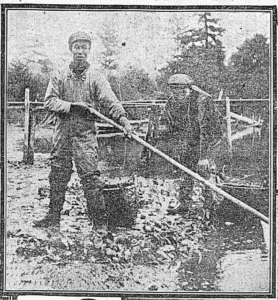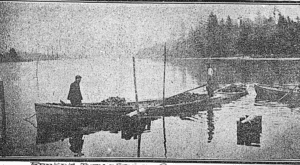Oyster Farming in Esquimalt Harbour
Colonist – Dec 13, 1908.
CULTIVATING EASTERN OYSTERS AT ESQUIMALT HARBOR.
“Half dozen on the half shell? Yes sir. Eastern?”
“No indeed. Give me Esquimalt oysters. There is flavor, size, and all else that the epicure prizes in the Esquimalt oyster.”
It was a Easterner, this oyster, but moved to the coast. It came young, in car-load lots, well-iced, from the beds of its childhood at Cape Cod and Bridgeport, Connecticut, over the Canadian Pacific Railway to find new beds in the rich harbor bottom of Esquimalt, where it waxed fat and prospered.

At Esquimalt, where sheltered in the little bay into whose head beneath Parsons bridge, the West Coast Fishing company has its oyster beds laid out in acre after acre covered with the shell-fish, those who care to follow the workers into the silt when the tide runs out at early morn can see the bivalve in its youth, its middle age, and in full growth. They can see the oysters sorted from its smaller fellows as the big rakes drag up from the bed to load the boats which lift the rising tide to carry the harvest gleaned at low water to the sorting house at the edge of the little cliff where Capt. George V. Williams, the manager, and Mrs. Williams in a cozy bungalow that looks out upon the harbor beyond, with the masts and funnels, rusted hulls and tapering staffs reminiscent of the days before he left the bridge of the Oriental liner Lyra to become oyster planter and manager of the company of Victoria, Vancouver and Tacoma men whose enterprise and cultivating Eastern Oysters at Esquimalt bids fair to be such a success.
There are now 4 million oysters in the Esquimalt beds. They do not propagate. The cold water is considered responsible for this, but if it does prevent the regeneration, it also has the effect growing the transplanted oysters better. A year ago, there were one and one half million young oysters at Esquimalt, and some months ago more were added until the beds contain over four millions. All were planted small, in the year of their childhood. They were not more than nine months old. They matured quick. Now, big shells, four, five, 6 inches long are lifted by the oyster tongs and piled high on the boats to pick them and load on the firm’s delivery wagons, which carry the load from Parsons bridge to Victoria for the local market, and the Vancouver market; these are the only fields yet invaded, but it is not long before the Northwest and Puget Sound markets will also be entered.
The little oysters, tiny shells, were brought by scow from where the C. P. R. cars were sidetracked at the edge of Esquimalt Harbour. When the tide was low the land on the harbor bottom had been cultivated. It had been tilled and raked as though a submarine farm had been intended. Pathways were made. The harbor bottom was laid off as for a giant chessboard, suggestive of the paddy field of the Oriental rice lands. Big rakes harrowed the mud, and soon, well cultivated, it was ready for planting. Branches planted in row after row until, with the rising water, the cove seemed like a flooded orchard, marking the pathways and borders of the beds, each approximately fifty feet square. Into these beds the planters placed from 100,000 to 200,000 young oysters, the number varying according to the condition of the soil. The oysters feed upon the insect life of the water, the animal life and vegetation of the soil and water, and some beds offer richer feeding grounds than others.

The beds once planted; time does the rest. Workers tend them, rake and sort them, prevent overcrowding, and as the days and weeks go by the shells grow, the oysters fatten and in time become ready for the market. Two and a half, perhaps three years is required for the young oyster to mature; to become ready to rest on the lower shell edged around the plate, with the central piece of lemon.
Capt. Williams, manager of the beds, brought some large succulent well flavored oysters from the near beds when a Colonist reporter and artist visited him and both are now witness to the flavor and general qualities of the Esquimalt oyster. It ranks ahead of the classes of oysters they have known. The oyster boats which come up to Montréal to lie where Bousecours market throws its shadow to the docks and small boys loot their tribute from the holds may come with their Malpeques, the Cape Cod beds may give their best flavored bivalves, the Japanese oysters may grace the low tables of the inns of Japan. There may be Blue Points for other diners, reporter and the artist care not; they are witnesses for the Esquimalt oyster.
They found Capt. Williams, his rubber boots reaching to his knees showing the silt of the tidelands, his pith helmet that is a relic of his far Eastern experiences tilted back on his head, waiting at the edge of the bluff, beneath the awning roof of his little bungalow. The view from that bungalow looking beyond where the branches jut from the water like young trees in a submerged orchard, beyond the gray buildings, empty and abandoned on Magazine island, their gray contrasting with the rich colorings of the arbutus and the autumn-tinged leaves of the clustering trees on the deserted island, is one well worth seeing. Beyond these things are ships, swinging at their anchors, the chains drawn tight; The waiting ships, steamers and sailers, black and red hulled, with little wisps of smoke lifting in the still air from the steamers stacks, and beyond, rising straight, is the smoke of the city lifting above the near greenery of the foreshore. It is a pretty sight. But Capt. Williams looks nearer. It is the avenues of branches that bound the oyster beds which he favors as a view. He laid out these beds for the West Coast fishing company of Victoria, in which he is associated with Dr. George L Milne, H A Dyer, WK Houston and L Ashwell, of Victoria, Col. Markham and Mr. Leonard of Vancouver and Capt. J A Mayham and Mr. Geer of Tacoma. He went to the oyster beds at Cape Cod and Bridgeport to select the young oysters and arrange for the first million and a half that came, and last spring he went and secured two and a half million more.

It is before sunrise, long before the dawn, when the gray of the approaching day offers just enough light to work, that the workers go out, rubber booted, into the soft mud of the then uncovered oyster beds. It is the long run-out. The water has receded far, and the flooded orchard of the high water is now a paddy field with bordering paths, groved with branches to mark them, and each square is gray with close-piled shells. The boats, moored over the beds, lie among the oysters. They are hauled to and fro, loosened up, and the full-grown ones are raked aside, to be shoveled, heaped high above the gunwales, into the grounded boats. Slowly the tide comes back, reaching further with every flow. The Chinese are soon working shin deep in water, raking and filling the heavily plaited wicker baskets that are used to load the oyster boats. Then, the water is knee-deep, they have to clamber into the boats, which have been floated, and the work of the day on the beds is at an end. They are driven back, bed by bed, to those nearer inshore by the rising tide, until, as the tide reaches its maximum, they are left paddling in the waters close inshore, raking the closer beds. If further work is necessary, they must go into their flat-bottom boats, armed with the double rakes which the oyster planter knows as “tongs” to lift the oysters from beneath the water. Most of the work, however, is done at low water.
At high water loaded boats are towed into the sorting house on the float at the edge of the jetty under the bluff were Capt. Williams has his home. There the sorters cull the morning’s take and the shipments for the market are prepared; the company’s delivery wagons are loaded and start for the stores were dealers sell to Mrs. Victoria.
The methods of culture at Esquimalt are somewhat dissimilar from those en vogue on the Atlantic side. There most of the planting is done in water where the bottom is never visible, often reaching a depth of thirty feet and upward. The ground varies there from quite soft to that almost as hard as asphalt pavement. Laborsaving devices, also, have been made a prominent factor in the economical development of the enterprises on the eastern coast, and steamers of a net register of fifty tons or more, equipped with large dredges, operated by steam hoisting apparatus, bring from the depths with these from fifteen hundred to twenty-five hundred bushels of oysters during the course of an ordinary day’s work. Here, as in most beds on the Pacific coast, the cultivation is carried on entirely in the shallow water, and the work is much easier. It is much more difficult to clean up the bottom of oysters where the bottom cannot be seen. Moreover, a deep bottom on this coast is impractical, as many oysters would be lost and money would be lost on the planting. In the East were oysters regenerate naturally, even if some are not obtained by the dredges, the cost of them has been nothing; while here where every oyster must be brought for planting, and in addition to the purchase price must pay a freight rate of $2.55 per 100 pounds, it will readily be seen that in oyster save is an oyster made, and an oyster not recovered is money lost. One big advantage processed by the Western beds is that the oyster beds are not threatened by the heavy freezes of the East, or where ice forms over the harbors and remains fast for from four to six months in some places, and the planters of the Pacific Coast do not have to be careful to avoid the dangers of freezing and thawing of the oysters and the carrying of them off in the ice drifts.
Machinery, too, enters little into the work in the West. The beds are soft bottomed, and dredges are not used to any extent for fear that the crust will be disturbed. The dredge used in the East is a huge and heavy rake or scraper which drags the oysters into a bag, the entire apparatus being lifted to the surface when the bag is full. At Esquimalt, when the tide has covered the beds, tongs are used instead of this method. A pair of tongs is geared to something like it pair of scissors with long wooden handles, except that instead of having blades, something like two rakes is used, and raise to the surface when filled with oysters. The use of rakes and short tongs is another method adopted.
For the past four years the Washington State Fish Commission has been carrying on a series of experiments at its fisheries experiment station at Keyport, endeavoring to find some method whereby the Eastern oysters might be propagated here. It has been found that the reproductive elements ripen and are cast into the water, but aside from an occasional oyster being found, practically no set results from this morning. The observations and experiments that have thus far been made seem to indicate that the temperature of the water is too low, particularly at night, and subject to too sudden changes for the young embryo to develop. It is possible that with some system of enclosed ponds or tanks where the temperature of the water can be controlled better results will follow.
The success attending the transplanting of the eastern oyster has suggested the possibility of introducing other species into our waters. Attention has been turned particularly to Japan, where they have several species of oysters, three, at least, of which are of commercial importance, the Japanese have developed quite a complicated system of cultivation and produce an immense number of excellent oysters. Those around Hiroshima attain about the size and shape of the Eastern “Blue Point.” The shells are deep and thin and have much the same general appearance as an eastern oyster. Further north, around some of the northern islands, another species is found which attains a much larger size. It is not cultivated to any extent, being a deep-water form. A study of the temperature and general conditions surrounding these Japanese oysters indicates that they would be particularly well adapted for transplanting here and it is possible they might propagate readily.
The Bellingham Bay Company recently made quite a large shipment from Hiroshima and planted on their beds near Whatcom. Through lack of proper packing and care and shipping many of these were lost, but enough were saved to indicate that better results may reward future efforts. Some of the other large companies are now seriously considering making shipments in the near future.
Among the native oysters of this vicinity probably the best beds known are those of Young Brothers, of the New England Hotel, at Sooke. Indians living in this vicinity can point out many places where there have been extensive beds of native oysters, the headwaters of Victoria Arm beyond the Gorge having at one time been well-stocked. Not only here but also on Puget Sound and in Oregon waters large areas could be found a few years ago where these oysters grew and flourished abundantly. The shell heaps on the shores of many bays show that the Indians have for many years visited these beds and obtained a large part of their food supply from them. The early settlers found in these oysters a substitute for the much larger oyster of the eastern coast, which has now followed them in their migration westward through the enterprise of a local syndicate.
As the cities grew the demand for oysters increased, and each year these natural beds were drawn on more and more heavily to supply the demand. Indians and white men resorted to them at all times and seasons, gathering the oysters by the canoe load and shipping them into the market. The starfish, too, ever an enemy of the oyster, came up from the deeper waters and so nearly completed the work of stripping the beds that today many that were once wonderfully productive are no longer oyster beds, but barren mud flats with a few shells to reflect the past productiveness.
